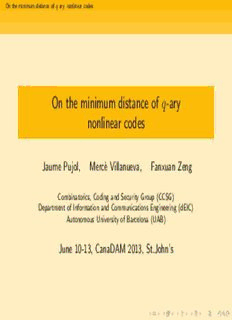
On the minimum distance of q-ary nonlinear codes - CanaDAM PDF
Preview On the minimum distance of q-ary nonlinear codes - CanaDAM
Ontheminimumdistanceofq-ary nonlinearcodes On the minimum distance of q-ary nonlinear codes Jaume Pujol, Merc`e Villanueva, Fanxuan Zeng Combinatorics, CodingandSecurityGroup(CCSG) Department ofInformationandCommunications Engineering (dEIC) Autonomous UniversityofBarcelona (UAB) June 10-13, CanaDAM 2013, St.John’s Ontheminimumdistanceofq-ary nonlinearcodes Outline Introduction Minimum weight and minimum distance Improvements on minimum weight and minimum distance Minimum weight and minimum distanceof q-arycodes Conclusions and future research Ontheminimumdistanceofq-ary nonlinearcodes Introduction Introduction Hamming Weight: or simply weight, of a vector v =(v1,...,vn) is the number of its entries which are nonzero. Hamming Distance: or simply distance, between two vectors v = (v1,...,vn) and w = (w1,...,wn) is the number of entries where they differ. An (n,M,d) code C is a subset of Fn, where F is a finite field of q q q q elements. We start from Binary Codes, which are subsets of Fn. 2 Ontheminimumdistanceofq-ary nonlinearcodes Introduction Introduction Given a code C, the problem of storing C in memory and finding out the minimum (Hamming) weight w(C) and minimum (Hamming) distance d(C) are well-known problems. • If C is linear, then it can be compactly represented using a generator matrix. Moreover, d(C) =w(C). • If C is nonlinear, then a solution would be to know whether it has another structure or not. For example, there are binary codes which have a Z4-linear or Z2Z4-linear structure and, therefore, they can also be compactly represented using a quaternary generator matrix. Ontheminimumdistanceofq-ary nonlinearcodes Introduction Introduction Given a code C, the problem of storing C in memory and finding out the minimum (Hamming) weight w(C) and minimum (Hamming) distance d(C) are well-known problems. • If C is linear, then it can be compactly represented using a generator matrix. Moreover, d(C) =w(C). • If C is nonlinear, then a solution would be to know whether it has another structure or not. For example, there are binary codes which have a Z4-linear or Z2Z4-linear structure and, therefore, they can also be compactly represented using a quaternary generator matrix. Ontheminimumdistanceofq-ary nonlinearcodes Introduction Introduction In general, binary codes without any of these structures can be represented as the union of cosets of a binary linear subcode of C. t C = K +c , i i[=0(cid:16) (cid:17) where c0 =0, t+1 = M/2k, M = |C| and K = {x ∈ Zn | x+C = C}. 2 The kernel K is the largest linear subcode for which it is true. The coset leaders are given by the set of t vectors: {c1,...,ct}. Ontheminimumdistanceofq-ary nonlinearcodes Introduction Introduction Since K is linear, the binary code C can be represented by the generator matrix of K and the set of coset leaders instead of a set of all its codewords. Then, the code C take up a memory space of order O(n(k+t)). Example 1 Memory space of binary codes of length n, M = 219 codewords and different dimension of kernel: dimension of kernel k 0 1 ... 17 19 number coset leaders t 219 218−1 ... 3 0 memory space 219n 218n ... 20n 19n Ontheminimumdistanceofq-ary nonlinearcodes Minimumweightandminimumdistance Minimum weight and distance • For linear codes, the best algorithm to obtain the minimum weight/distance based on the enumeration of some codewords is the Brouwer-Zimmermann algorithm. • For nonlinear codes, there is no other algorithms but the enumeration of all codeswords, that is, the brute force algorithm. Ontheminimumdistanceofq-ary nonlinearcodes Minimumweightandminimumdistance A short introduction to Brouwer-Zimmermann’s Algorithm (cid:3)(cid:5) (cid:2) (cid:1) (cid:3) (cid:1) (cid:1) (cid:1)(cid:2)(cid:2) (cid:3) (cid:3) (cid:1) (cid:2) (cid:2) (cid:1)(cid:1)(cid:1) (cid:4)(cid:5)(cid:6)(cid:5)(cid:7)(cid:8)(cid:7)(cid:9)(cid:10)(cid:11)(cid:5)(cid:12)(cid:13)(cid:14)(cid:9)(cid:15)(cid:16)(cid:9)(cid:11)(cid:6)(cid:8)(cid:7)(cid:11)(cid:3)(cid:17)(cid:14)(cid:11)(cid:18)(cid:9)(cid:19)(cid:11)(cid:20)(cid:14)(cid:15)(cid:3)(cid:21) (cid:3) (cid:1) (cid:2) (cid:2) (cid:4)(cid:5)(cid:6)(cid:5)(cid:7)(cid:8)(cid:7)(cid:9)(cid:10)(cid:11)(cid:5)(cid:12)(cid:13)(cid:14)(cid:9) (cid:1)(cid:1)(cid:1) (cid:3) (cid:1) (cid:4) (cid:4) (cid:22)(cid:15)(cid:10)(cid:11)(cid:3)(cid:9)(cid:23)(cid:15)(cid:8)(cid:6)(cid:18)(cid:9)(cid:15)(cid:16)(cid:9)(cid:8)(cid:6)(cid:11)(cid:6)(cid:8)(cid:7)(cid:11)(cid:3)(cid:17)(cid:14)(cid:11)(cid:18)(cid:9)(cid:19)(cid:11)(cid:20)(cid:14)(cid:15)(cid:3)(cid:21) (cid:9)(cid:9)(cid:9)(cid:9)(cid:9)(cid:9)(cid:9)(cid:9)(cid:9)(cid:9)(cid:9)(cid:9)(cid:9)(cid:9)(cid:9)(cid:9)(cid:9)(cid:9)(cid:13)(cid:24)(cid:3)(cid:25)(cid:26)(cid:27) Ontheminimumdistanceofq-ary nonlinearcodes Minimumweightandminimumdistance Minimum weight and distance Extend Coset: Given a binary code C and a vector v, denote K = K ∪(K +v) as an extend coset of C. Since K is linear, v then K is also linear, and can be constructed as hBasis(K),vi. v t Let C = K +c with t ≥ 2. i=0 i S (cid:0) (cid:1) Proposition / Algorithm 1 (MinW) The minimum weight of C is min({w(K ) | 1 ≤ i ≤ t}). ci Proposition / Algorithm 2 (MinD) The minimum distance of C is min({w(Kci) | 1 ≤ i≤ t}∪{w(Kci+cj) | 1 ≤ i < j ≤ t}).
Description: